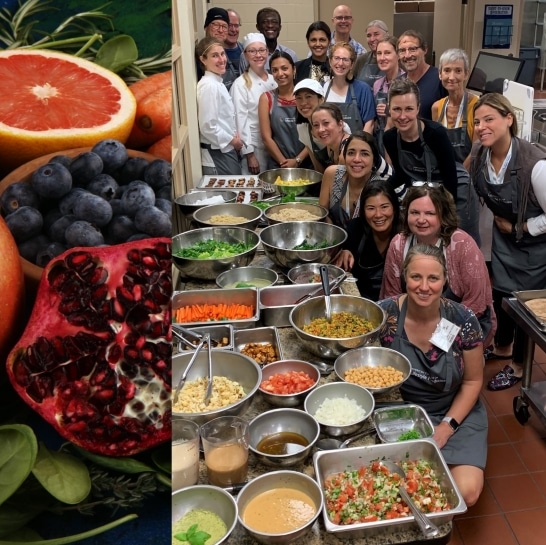What is Culinary Medicine and why is it important?
Culinary medicine (CM) is an evidence-based field that brings together nutrition and culinary knowledge and skills to assist patients in maintaining health and preventing and treating food-related disease by choosing high-quality, healthy food in conjunction with appropriate medical care. Diet has been identified as the single most important risk factor for morbidity and mortality in the United States, yet most health care providers spend relatively few hours learning about nutrition during their training. The nutrition education that is offered is often primarily didactic and focused on the biochemistry of nutrients and health consequences of deficiency states. This content is of limited use in a clinical setting where the majority of the population faces overnutrition due to high intake of ultra-processed, calorie-dense foods. CM fills this educational gap by focusing on practical dietary behavior changes, food knowledge, and cooking skills needed to move toward a healthier diet. Considering potential limitations related to time availability, financial resources, and cultural food traditions is an important part of any successful CM program. CM can be thought of as the applied, laboratory portion of a nutrition curriculum for students and trainees. Such training can be provided as part of the 4-year medical school curriculum, incorporated later as continuing medical education, or included in training programs for those in health professional fields.
What is a whole food, plant-based diet?
The curriculum highlights a predominantly whole food, plant-based (WFPB) diet, as recommended by ACLM. The WFPB diet is a dietary pattern centered on whole, plant foods including vegetables, fruits, whole grains, legumes, nuts and seeds. While a number of dietary patterns have been associated with prevention and treatment of common chronic diseases, the WFPB diet is the only diet shown to reverse coronary artery disease – a leading cause of heart disease that iis responsible for one in every four deaths for those over age 35. Media reports on nutrition research tend to foster confusion about what makes up a healthy diet by focusing on nuances. However, the vast majority of nutrition scientists and public health experts agree on the health benefits of diets rich in whole, plant foods and low in processed foods. Journalist Michael Pollan put it more simply: “Eat food. Not too much. Mostly plants.” Patients encountered in clinical practice will be in different places with regard to level of interest, motivation, and ability to change dietary behaviors. Therefore, the curriculum consists of a predominantly WFPB approach, along with a variety of tools, tips, and techniques that can help patients successfully move along a continuum of increasingly whole, plant foods in their diets.
How can this curriculum be used?
This curriculum was designed to provide detailed guidance on how to organize and execute a flipped classroom CM course for medical and/or health professional students. A flipped classroom model is one in which much of the didactic content and reading materials are viewed online or read ahead of class in order to allow class time to be spent doing interactive activities – in this case, hands-on cooking and interactive dinner discussions. Most sessions recommend 10-30 minutes of video content, plus recipes and other handouts to be watched/read/reviewed prior to each session. The curriculum is intended to provide an open-source template for instructors seeking to start CM courses at their institution. This curriculum was adapted for the American College of Lifestyle Medicine from the successful Teaching Kitchen Elective Course for Medical Students at Stanford University School of Medicine, which was held multiple times as a quarter-long elective course. For patient, public, or undergraduate education, simply omit portions of the curriculum aiming to teach health care providers to assist patients in making dietary changes.
Who might use this curriculum to teach a Culinary Medicine course?
The curriculum was designed to be taught by a professional (or professionals) trained in culinary arts (or very comfortable in the kitchen), nutrition, and the health professional background of the students taking the course.* This can be one person with training in all areas or more than one person. In addition to a primary instructor, it is highly recommended to supplement the primary instructor with practicing physician faculty volunteers (or applicable allied health care professionals) representing different clinical backgrounds. This is particularly useful if holding the CM course for trainees as they may intend to go into different fields and may benefit from learning how course content is applicable to a variety of disciplines.
*Note: if using for patient care, then ideally the instructor would include a member or members of the patient care team with experience in cooking, nutrition, and the medical specialty of the clinic in which the patients are attending.
What do I need to consider before getting started?
Size of the course, available space and resources, access to a teaching kitchen space (pop-up, mixed-use, or permanent), safety measures, shopping, setup and cleanup time, budget and waivers are key course considerations. Please refer to page 37 of the Culinary Medicine Curriculum for a list of course logistics to consider.
Can I share this material?
This course material is to be utilized by individuals, institutions and organizations to educate groups and classes of students about the foundations of Culinary Medicine. Downloaded content is not allowed to be distributed or shared with those who have not been granted explicit access to the material. If using individual pages rather than the curriculum as a whole, please include the following:
Copyright © 2019 Michelle Hauser, MD, MS, MPA, FACLM, Chef. All rights reserved.
Published and distributed by the American College of Lifestyle Medicine (lifestylemedicine.org). All rights reserved.
Author and/or Publisher will, however, grant a complimentary license to copy, use, perform and display this publication and its contents and to create and distribute derivative works for any reasonable, non-commercial purpose, subject to proper attribution of authorship and ownership. Direct permission requests to the American College of Lifestyle Medicine, addressed “Attention: Director of Education,” at the following address:
P.O. Box 6432
Chesterfield, MO 63006


